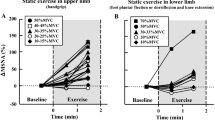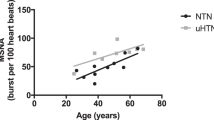Abstract
Muscle nerve sympathetic activity (MSA; involved in blood pressure regulation) was recorded by microneurography in the peroneal nerve for 90 min after ingestion of 100 gd-glucose in three groups of healthy subjects: young subjects (mean age 26 years) and 70-year-old men with normal and reduced insulin sensitivity as assessed by euglycaemic insulin clamp. Muscle nerve sympathetic activity at rest was lowest in the young and highest in the insulin-resistant subjects (burst frequencies 19.8±6.0, 47.7±7.0 and 55.1±11.5 bursts/min for the three groups, respectively). The young subjects responded to glucose intake with a pronounced increase in MSA, a response that was blunted in the elderly and weakest in the insulin-resistant subjects. A similar relationship was observed during a Valsalva manoeuvre, indicating that the blunted response in the elderly is a generalized phenomenon. Blood pressure remained stable in the young subjects but fell slightly and significantly in the elderly subjects. It is concluded that old subjects utilize their total capacity for MSA close to maximum at rest. Thus, the reserve for response to stimuli normally evoking a strong increase in MSA is restricted. This restriction may contribute to postprandial hypotension in the healthy elderly.
Similar content being viewed by others
References
Lipsitz LA, Nyquist RP, Wei JY, Rowe JW. Postprandial reduction in blood pressure in the elderly.N Engl J Med 1983;309: 81–83.
Jansen RWMM, Lipsitz LA. Postprandial hypotension: epidemiology, pathophysiology, and clinical management.Ann Intern Med 1995;122: 286–295.
Sundlöf G, Wallin BG. Variability of muscle nerve sympathetic activity in resting recumbent man.J Physiol (London) 1977;272: 383–397.
Yamada Y, Miyajima E, Tochikubo O, Matsukawa T, Ishii M. Agerelated changes in muscle sympathetic nerve activity in essential hypertension.Hypertension 1989;13: 870–877.
Ebert TJ, Morgan BJ, Barney JA, Denahan T, Smith JJ. Effects of aging on baroreflex regulation of sympathetic activity in humans.Am J Physiol 1992;263 (Heart Circ Physiol 32): H798-H803.
Ng AV, Callister R, Johnson DG, Seals DR. Age and gender influence muscle sympathetic nerve activity at rest in healthy humans.Hypertension 1993;21: 498–503.
Scherrer U, Randin D, Tappy L, Vollenweider P, Jéquier E, Nicod P. Body fat and sympathetic nerve activity in healthy subjects.Circulation 1994;89: 2634–2640.
Vollenweider P, Randin D, Tappy T, Jéquier E, Nicod P, Scherrer U. Impaired insulin-induced sympathetic neural activation and vasodilation in skeletal muscle in obese humans.J Clin Invest 1994;93: 2365–2371.
Spraul M, Anderson EA, Bogardus C, Ravussin E. Mucle sympathetic nerve activity in response to glucose ingestion. Impact of plasma insulin and body fat.Diabetes 1994;43: 191–196.
Berme C, Fagius J, Niklasson F. Sympathetic response to oral carbohydrate administration. Evidence from microelectrode nerve recordings.J Clin Invest 1989;84: 1403–1409.
Fagius J, Berne C. Increase in muscle nerve sympathetic activity in humans after food intake.Clin Sci 1994;86: 159–167.
Anderson EA, Hoffman RP, Balon TW, Sinkey CA, Mark AL. Hyperglycaemia produces both sympathetic neural activation and vasodilatation in normal humans.J Clin Invest 1991;87: 2246–2252.
Berne C, Fagius J, Pollare T, Hjemdahl P. The sympathetic response to euglycaemic hyperinsulinaemia. Evidence from microelectrode nerve recordings in healthy subjects.Diabetologia 1992;35: 873–879.
Hedstrand H. A study of middle-aged men with particular reference to risk factors for cardiovascular disease.Ups J Med Sci 1975;9 (suppl.): 1–61.
Skarfors ET, Selinus I, Lithell HO. Risk factors for developing non-insulin dependent diabetes mellitus: a 10 year follow up of men in Uppsala.Br Med J 1991;303: 755–760.
DeFronzo RA, Tobin JD, Andres R. Glucose clamp technique: a method for quantifying insulin secretion and resistance.Am J Physiol 1979;237: 214–223.
WHO Expert Committee. Diabetes mellitus. World Health Organization Technical Report Series no. 727. Geneva: WHO, 1985; 80 pp.
Matthews DR, Hosker JP, Rudenski AS, Naylor BA, Treacher DF, Turner RC. Homeostasis model assessment: insulin resistance and B-cell function from fasting plasma glucose and insulin concentrations in man.Diabetologia 1985;28: 412–419.
Wallin BG, Fagius J. Peripheral sympathetic neural activity in conscious humans.Annu Rev Physiol 1988;50: 565–576.
Delius W, Hagbarth K-E, Hongell A, Wallin BG. Maneouvres affecting sympathetic outflow in human muscle nerves.Acta Physiol Scand 1972;84: 82–94.
Passon PG, Peuler JD. A simplified radiometric assay for plasma norepinephrine and epinephrine.Anal Biochem 1973;51: 618–631.
Fagius J, Wallin BG. Long-term variability and reproducibility of human muscle nerve sympathetic activity at rest, as reassessed after a decade.Clin Auton Res 1993;3: 201–205.
Sundlöf G, Wallin BG. Human muscle nerve sympathetic activity at rest. Relationship to blood pressure and age.J Physiol (London) 1978;274: 621–637.
Griffin B, Pickering TG, Sleight P, Peto R. Effect of age and high blood pressure on baroreflex sensitivity in man.Circulation Res 1971;29: 424–431.
Shimada K, Kitazumi T, Sadakane N, Ogura H, Ozawa T. Agerelated changes of baroreflex function, plasma norepinephrine, and blood pressure.Hypertension 1985;7: 113–117.
Anderson B, Elam M, Wallin BG, Björntorp B, Andersson OK. Effects of energy-restricted diet on sympathetic muscle nerve activity in obese women.Hypertension 1991;18: 783–789.
Fagius J, Wallin BG, Sundlöf G, Nerhed C, Englesson S. Sympathetic outflow in man after anaesthesia of the glossopharyngeal and vagus nerves.Brain 1985;108: 423–438.
Eckberg DL, Rea RF, Andersson OK et al. Baroreflex modulation of sympathetic activity and sympathetic neurotransmitters in humans.Acta Physiol Scand 1988;133: 221–231.
Fagius J, Sundlöf G. The diving response in man: effects on sympathetic activity in muscle and skin nerve fascicles.J Physiol (London) 1986;377: 429–443.
Sanders JS, Mark AL, Ferguson DW. Importance of aortic baroreflex in regulation of sympathetic responses during hypotension. Evidence from direct sympathetic nerve recordings in humans.Circulation 1989;79: 83–92.
Fagius J, Karhuvaara S, Sundlöf G. The cold pressor test: effects on sympathetic nerve activity in human muscle and skin nerve fascicles.Acta Physiol Scand 1989;137: 325–334.
Saito M, Mano T, Iwase S. Changes in muscle sympathetic nerve activity and calf blood flow during static handgrip exercise.Eur J Appl Physiol 1990;60: 277–281.
Wallin BG, Sundlöf G, Eriksson B-M, Dominiak P, Grobecker H, Lindblad LE. Plasma noradrenaline correlates to sympathetic muscle nerve activity in normotensive man.Acta Physiol Scand 1981;111: 69–73.
Young JB, Rowe JW, Pallotta JA, Sparrow D, Landsberg L. Enhanced plasma norepinephrine response to upright posture and oral glucose administration in elderly human subjects.Metabolism 1980;29: 532–539.
Potter JF, Heseltine D, Hartley G, Matthews J, Macdonald IA, James OFW. Effects of meal composition on the postprandial blood pressure, catecholamine and insulin changes in elderly subjects.Clin Sci 1989;77: 265–272.
Jansen RWMM, Peeters TL, van Lier HJJ, Hoefnagels WHL. The effect of oral glucose, protein, fat and water loading on blood pressure and the gastrointestinal peptides VIP and somatostatin in hypertensive elderly subjects.Eur J Clin Invest 1990;20: 192–198.
Heseltine D, Dakkak M, Macdonald IA, Bloom SR, Potter JE. Effects of carbohydrate type on postprandial blood pressure, neuroendocrine and gastrointestinal hormone changes in the elderly.Clin Auton Res 1991;1: 219–224.
Lipsitz LA, Pluchino FC, Wei JY, Minaker KL, Rowe JW. Cardiovascular and norepinephrine responses after meal consumption in elderly (older than 75 years) persons with postprandial hypotension and syncope.Am J Cardiol 1986;58: 810–815.
Lipsitz LA, Ryan SM, Parker JA, Freeman R, Wei JY, Goldberger AL. Hemodynamic and autonomic nervous system responses to mixed meal ingestion in healthy young and old subjects and dysautonomic patients with postprandial hypotension.Circulation 1993;87: 391–400.
Sidery MB, Cowley AJ, Macdonald IA. Cardiovascular responses to a high-fat and a high-carbohydrate meal in healthy subjects.Clin Sci 1993;84: 263–270.
Robertson D, Wade D, Robertson RM. Postprandial alterations in cardiovascular hemodynamics in autonomic dysfunction states.Am J Cardiol 1981;48: 1048–1052.
Mathias CJ, da Costa DF, Fosbraey P et al. Cardiovascular, biochemical and hormonal changes during food-induced hypotension in chronic autonomic failure.J Neurol Sci 1989;94: 255–269.
Kingwell BA, Thompson JM, Kaye DM, McPherson GA, Jennings GL, Esler MD. Heart rate spectral analysis, cardiac norepinephrine spillover, and muscle sympathetic nerve activity during human sympathetic nervous activation and failure.Circulation 1994;90: 234–240.
Hakusui S, Sugiyama Y, Iwase S et al. Postprandial hypotension: microneurographic analysis and treatment with vasopressin.Neurology 1991;41: 712–715.
Author information
Authors and Affiliations
Rights and permissions
About this article
Cite this article
Fagius, J., Ellerfelt, K., Lithell, H. et al. Increase in muscle nerve sympathetic activity after glucose intake is blunted in the elderly. Clinical Autonomic Research 6, 195–203 (1996). https://doi.org/10.1007/BF02291134
Received:
Accepted:
Issue Date:
DOI: https://doi.org/10.1007/BF02291134




